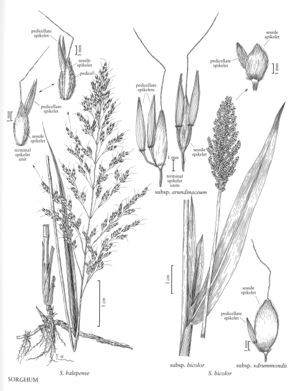Difference between revisions of "Sorghum halepense"
FNA>Volume Importer |
FNA>Volume Importer |
||
| Line 17: | Line 17: | ||
-->{{Treatment/Body | -->{{Treatment/Body | ||
|distribution=Conn.;N.J.;N.Y.;Wash.;Va.;W.Va.;Del.;D.C;Wis.;Idaho;Mont.;Oreg.;Wyo.;Pacific Islands (Hawaii);Fla.;Puerto Rico;N.Mex.;Tex.;La.;Tenn.;N.C.;S.C.;Pa.;Nev.;Colo.;Ont.;Calif.;Ala.;Kans.;N.Dak.;Nebr.;Okla.;S.Dak.;Mass.;N.H.;Vt.;Ark.;Ill.;Ga.;Ind.;Iowa;Ariz.;Md.;Ohio;Utah;Mo.;Mich.;R.I.;Miss.;Ky. | |distribution=Conn.;N.J.;N.Y.;Wash.;Va.;W.Va.;Del.;D.C;Wis.;Idaho;Mont.;Oreg.;Wyo.;Pacific Islands (Hawaii);Fla.;Puerto Rico;N.Mex.;Tex.;La.;Tenn.;N.C.;S.C.;Pa.;Nev.;Colo.;Ont.;Calif.;Ala.;Kans.;N.Dak.;Nebr.;Okla.;S.Dak.;Mass.;N.H.;Vt.;Ark.;Ill.;Ga.;Ind.;Iowa;Ariz.;Md.;Ohio;Utah;Mo.;Mich.;R.I.;Miss.;Ky. | ||
| − | |discussion=<p | + | |discussion=<p>Sorghum halepense is native to the Mediterranean region. It is sometimes grown for forage in North America, but it is considered a serious weed in warmer parts of the United States. It hybridizes readily with S. bicolor, and derivatives of such hybrids are widespread. The annual Sorghum xalmum Parodi, which has wider (2-2.8 mm) sessile spikelets with more veins in the lower glumes (13-15 versus 10-13) than S. halepense, is one such derivative.</p> |
|tables= | |tables= | ||
|references= | |references= | ||
| Line 33: | Line 33: | ||
|basionyms= | |basionyms= | ||
|family=Poaceae | |family=Poaceae | ||
| + | |illustrator=Linda A. Vorobik and Hana Pazdírková | ||
|distribution=Conn.;N.J.;N.Y.;Wash.;Va.;W.Va.;Del.;D.C;Wis.;Idaho;Mont.;Oreg.;Wyo.;Pacific Islands (Hawaii);Fla.;Puerto Rico;N.Mex.;Tex.;La.;Tenn.;N.C.;S.C.;Pa.;Nev.;Colo.;Ont.;Calif.;Ala.;Kans.;N.Dak.;Nebr.;Okla.;S.Dak.;Mass.;N.H.;Vt.;Ark.;Ill.;Ga.;Ind.;Iowa;Ariz.;Md.;Ohio;Utah;Mo.;Mich.;R.I.;Miss.;Ky. | |distribution=Conn.;N.J.;N.Y.;Wash.;Va.;W.Va.;Del.;D.C;Wis.;Idaho;Mont.;Oreg.;Wyo.;Pacific Islands (Hawaii);Fla.;Puerto Rico;N.Mex.;Tex.;La.;Tenn.;N.C.;S.C.;Pa.;Nev.;Colo.;Ont.;Calif.;Ala.;Kans.;N.Dak.;Nebr.;Okla.;S.Dak.;Mass.;N.H.;Vt.;Ark.;Ill.;Ga.;Ind.;Iowa;Ariz.;Md.;Ohio;Utah;Mo.;Mich.;R.I.;Miss.;Ky. | ||
|reference=None | |reference=None | ||
| Line 38: | Line 39: | ||
|publication year= | |publication year= | ||
|special status= | |special status= | ||
| − | |source xml=https:// | + | |source xml=https://bibilujan@bitbucket.org/aafc-mbb/fna-data-curation.git/src/314eb390f968962f596ae85f506b4b3db8683b1b/coarse_grained_fna_xml/V25/V25_1530.xml |
|subfamily=Poaceae subfam. Panicoideae | |subfamily=Poaceae subfam. Panicoideae | ||
|tribe=Poaceae tribe Andropogoneae | |tribe=Poaceae tribe Andropogoneae | ||
Revision as of 17:16, 30 October 2019
Plants perennial; rhizomatous. Culms 50-200 cm tall, 0.4-2 cm thick; nodes appressed pubescent; internodes glabrous. Ligules 2-6 mm, membranous, conspicuously ciliate; blades 10-90 cm long, 8-40 mm wide. Panicles 10-50 cm long, 5-25 cm wide, primary branches compound, terminating in rames of 1-5 spikelet pairs; disarticulation usually beneath the sessile spikelets, sometimes also beneath the pedicellate spikelets. Sessile spikelets bisexual, 3.8-6.5 mm long, 1.5-2.3 mm wide; calluses blunt; glumes indurate, shiny, appressed pubescent; upper lemmas unawned, or with a geniculate, twisted awn to 13 mm; anthers 1.9-2.7 mm. Pedicels 1.8-3.3 mm. Pedicellate spikelets staminate, 3.6-5.6 mm; glumes membranous to coriaceous, unawned. Caryopses not exposed at maturity. 2n = 20, 40; several dysploid counts also reported.
Distribution
Conn., N.J., N.Y., Wash., Va., W.Va., Del., D.C, Wis., Idaho, Mont., Oreg., Wyo., Pacific Islands (Hawaii), Fla., Puerto Rico, N.Mex., Tex., La., Tenn., N.C., S.C., Pa., Nev., Colo., Ont., Calif., Ala., Kans., N.Dak., Nebr., Okla., S.Dak., Mass., N.H., Vt., Ark., Ill., Ga., Ind., Iowa, Ariz., Md., Ohio, Utah, Mo., Mich., R.I., Miss., Ky.
Discussion
Sorghum halepense is native to the Mediterranean region. It is sometimes grown for forage in North America, but it is considered a serious weed in warmer parts of the United States. It hybridizes readily with S. bicolor, and derivatives of such hybrids are widespread. The annual Sorghum xalmum Parodi, which has wider (2-2.8 mm) sessile spikelets with more veins in the lower glumes (13-15 versus 10-13) than S. halepense, is one such derivative.
Selected References
None.
